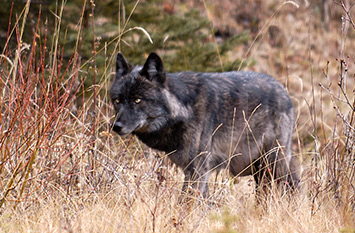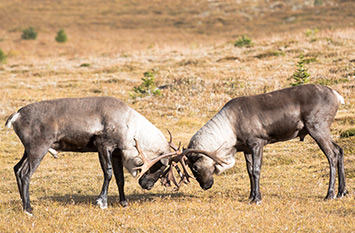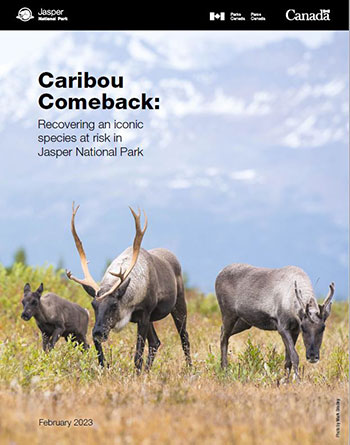
Caribou comeback: Recovering an iconic species at risk in Jasper National Park
Jasper National Park
Updated February 2023
Caribou comeback: Recovering an iconic species at risk in Jasper National Park is a summary of the reasons caribou have declined in the national park, steps Parks Canada has taken to reduce threats to caribou, and Parks Canada’s conservation breeding program to rebuild small caribou herds in Jasper National Park.
In this document, the terms caribou “population” and “herd” are used to mean a caribou subpopulation within a specific geographic area or range. The Government of Canada identifies 38 subpopulations of southern mountain caribou, including the Banff, Brazeau, Maligne and Tonquin subpopulations with habitat in Banff and Jasper national parks, and the Columbia South subpopulation with habitat in Mount Revelstoke and Glacier national parks.

-
Caribou in Jasper National Park are at risk
Caribou have roamed the peaks and valleys of what is now Jasper National Park for millennia. They rely on the vast and undisturbed habitat found in the mountains and forests of the Rocky Mountains. During long, cold winters caribou survive by digging through snow-covered slopes to eat lichens. That survival is now precarious.
Precise historical caribou population sizes in Jasper National Park are difficult to know. We know that the number of mountain caribou used to be much larger and more widely distributed. Indigenous Knowledge holders and archaeological research have identified the coexistence of humans and caribou in this landscape for thousands of years. A radiocarbon-dated caribou antler found melted out of an ice patch shows that caribou have existed here for at least 1300 years.
More recently, written records from the early 1970s show that there were several caribou populations with hundreds of animals. Over the last fifty years, those numbers have become drastically lower. Populations are so small that they cannot recover on their own. By rebuilding the dwindling herds of caribou in Jasper National Park, we can ensure the continued existence of some of the world’s southernmost caribou.
-
Park management practices of the early 1900s are at the root of the problem

When Jasper National Park was established in 1907, there were few elk or wolves in the area. Elk populations were virtually zero due to hunting and some severe winters. Wolves were viewed as pests and were regularly killed. Early park managers then introduced wildlife management practices that altered elk and wolf populations for decades. This had long-term effects on caribou.
Eighty-eight elk were reintroduced to Jasper from Yellowstone National Park in 1920. At the same time, a predator control program kept wolf numbers very low. Without predators, the elk population soared to a height of roughly 3000 in the mid-1930s and remained high, numbering about 2500 into the late 1960s. When wolf control practices ended abruptly in 1959, wolves had a plentiful food source of elk and quickly multiplied in the park.
Mountain caribou avoid predators like wolves by living at higher elevations. As the density of wolves increased after wolf control ended, wolves used caribou habitat more often and they naturally preyed on caribou they came across. Wolf density remained high between 1959 and 2006. During this period, the population and distribution of elk eventually declined. Caribou populations also declined, but to a much greater degree — caribou are less abundant and reproduce more slowly than elk.
Wolf numbers remained high for many decades but naturally declined as elk became less plentiful. As resource managers came to better understand these dynamics between predator and prey, Parks Canada developed wildlife management practices to lessen human influence. This included moving elk away from town, where they take refuge from predators. Parks Canada also began incinerating roadkill rather than discarding it into gravel pits where wolves could access it and supplement their diet. By the time wolf populations in the park declined to more sustainable levels in 2014, the Maligne, Brazeau, and Tonquin caribou herds had become very small.

Number of elk and number of wolves by year
Text version
This graph shows trends in the approximate abundance of elk (blue), and wolves (purple), in Jasper National Park from 1900 to 2020. Elk were reintroduced in 1920 while predator control was ongoing (1900-1959). Severe winters affected the elk population in the late 1940s and early 1970s. -
Parks Canada has acted to reduce many of the influences on caribou decline
Parks Canada has taken steps to reduce many of the threats to caribou in Jasper National Park. Since 2006, these actions have reduced human influence on wolf and elk populations, limited the effects of human recreation on caribou, and protected caribou habitat.
The Canada National Parks Act and Species at Risk Act protect caribou and their habitat. Starting in 2006, Parks Canada implemented the following actions in Jasper National Park:
- Changed how we disposed of roadkill so that wolves can no longer access it and artificially supplement their diet, preventing unnatural predator population growth.
- Closed occupied caribou ranges in winter, so human trails and roads don’t give wolves unnatural and easy access to caribou habitat.
- Discontinued cross-country ski track-setting and the use of snowmobiles (for park or outfitter operations) in caribou habitat, to prevent wolves from using packed trails to access the herds in winter.
- Approved Marmot Basin Ski Area’s site guidelines and long-range plan, which reduced the ski area’s leasehold by 17%, created 118 hectares of wilderness habitat to benefit caribou and other wildlife, and put limits on ski lift development.
- Prohibited to bicycles, dogs, and landing and takeoff by hang gliders and paragliders in caribou habitat, to avoid disturbing caribou.
- Prohibited trail development, limited the number of random camping permits available, and reduced random camping group sizes in caribou habitat.
- Provided guidelines for aircraft flying over wildlife in alpine areas of the park.
- Set up reduced highway speed zones and warning signs in areas where caribou are known to cross the road, to protect caribou from traffic accidents.
- Ongoing assessments of projects, including prescribed fire, for their impact on caribou and caribou habitat.
- Ongoing monitoring of wolves, elk, deer, and caribou to understand changes in their populations.
- Ongoing research and monitoring to understand the potential for large-scale habitat changes caused by fire, forest insects, climate change, human activities, the introduction of non-native species to an ecosystem, or wildlife management practices.
Taking these steps has created better conditions for caribou survival and recovery. However, our actions could not overcome the impact of high wolf density on caribou herds before 2014. As populations decline, they become more vulnerable to natural threats such as predators, disease, and accidents. Caribou population are now too small to recover on their own.
-
Without intervention, the Brazeau and Tonquin herds will disappear

Two of five caribou herds in Banff and Jasper national parks are gone. The last five Banff caribou died in an avalanche in April 2009. In Jasper, there has been no sign of any Maligne caribou since 2018. Caribou continue to persist in small numbers in the Tonquin and Brazeau herds of Jasper National Park, and in larger numbers in the À la Pêche herd on Jasper’s northern boundary.
Parks Canada estimates there are about 50 caribou in the Tonquin population, including 8 to 13 adult females (2021 modeling). A minimum of 44 caribou were counted in the Tonquin in 2022. Fewer than 10 caribou have been counted in the Brazeau herd for many years, with only one to three breeding females. Despite having stable numbers since 2015, this small number of reproductive females cannot produce enough calves each year to grow the population.
The Government of Alberta estimates there are about 150 caribou in the À la Pêche population (2018 estimate). These partially migratory caribou are primarily managed and monitored by the Province of Alberta. Parks Canada records and monitoring data indicate that some caribou stay in Jasper National Park year-round, some stay in the foothills of Alberta’s Rocky Mountains, and some migrate back and forth. Recovery efforts by the Province of Alberta, including wolf management outside of national park boundaries, have led to this population stabilizing and growing.
-
Current conditions in Jasper National Park can support larger caribou populations

Parks Canada’s conservation actions have reduced threats to caribou and contributed to a natural and steady decline in wolf and elk density over the past decade.
- Wolf density is estimated to be 1.2 wolves per 1000 km² (2020—2021 estimate) compared to 3.4 in 2011 and 6.2 in 2004. This number is sufficiently low to support self-sustaining caribou populations.
- The elk population is estimated to be 233 to 323 animals (2022—2023 estimate). This number has been consistent for about a decade and is not expected to change significantly in the future.
Jasper National Park has abundant habitat for caribou. Current ecological conditions are also favourable for supporting larger caribou populations. The park provides a unique, protected space where southern mountain caribou herds may have the best chance of recovery and long-term survival.
Ongoing monitoring and research to understand the risk of predation on caribou, as well as the impacts of our conservation actions, climate change and other uncertainties, will guide how Parks Canada adapts its conservation measures.
-
The best option to recover small caribou herds in Jasper is through a conservation breeding program
Parks Canada’s wildlife specialists have worked with experts from governments, Indigenous partner communities, academia and conservation organizations around the world to understand how to best protect and recover caribou in Jasper National Park as part of the broader Multi-Species Action Plan for Jasper National Park.
Parks Canada has a plan to rebuild the Tonquin caribou population, and eventually the Brazeau and Maligne populations, through conservation breeding. Conservation breeding programs are used to prevent animal species from becoming extinct and to help in their recovery. This involves capturing a small number of wild animals, breeding them in captivity, and releasing their offspring back into the wild to increase populations of endangered wildlife.
Consultation and engagement with scientists, researchers, Indigenous peoples, stakeholders and the public show strong scientific, cultural and social support for Jasper National Park’s conservation breeding program.
-
Parks Canada’s new caribou conservation breeding program will raise and release caribou into the Tonquin population
Through a conservation breeding and release program — the first of its kind for caribou in Canada — Parks Canada will:
- build a conservation breeding centre in Jasper National Park
- capture a small number of wild caribou from local (and potentially regional) populations and move them into captivity
- raise a herd of caribou at the centre, where calves are born each year
- release young caribou born in the centre into the wild Tonquin population, and repeat each year until the Tonquin herd reaches about 200 animals
- monitor the animals and collaborate with partners and experts to adapt the program based on what is learned
- explore releasing caribou from the centre into areas of the park where herds have disappeared.
-
Parks Canada envisions a future where caribou thrive on their own

Parks Canada could begin to welcome the first wild caribou into Jasper’s breeding centre as early as 2025. That means the first yearlings born in the facility could be released into the Tonquin population the following year. Modelling shows a good probability that up to 35 to 38 calves could be born to about 40 adult females in captivity each year, with most being released into the wild.
The goal is to rebuild the Tonquin herd to 200 caribou within 5 to 10 years after the first caribou are released. Based on the experience and results with the Tonquin herd, Parks Canada will explore releasing animals back into the Brazeau and Maligne ranges to reach populations of 300 to 400 caribou among the three caribou ranges.
There is uncertainty in this program. There are risks and there could be delays. Some caribou will die in captivity and others after release into the wild. Even taking these risks into account, research shows this program has a good chance of successfully restoring caribou populations to their traditional habitat in Jasper, rather than losing them forever.
-
We are working together to restore caribou populations and reverse biodiversity loss
The protection and recovery of species at risk across the country is an important part of our shared natural and cultural heritage. The Government of Canada’s investment in Parks Canada’s caribou conservation breeding program aims to restore caribou populations in Jasper National Park and support Canada’s biodiversity goals.
Parks Canada is working together with Indigenous partners, the governments of Alberta and British Columbia, Environment and Climate Change Canada and experts around the world to find the best ways to bring caribou into the program. This includes ensuring their health and well-being while in care, giving them the best chance of survival after they are released into the wild, and supporting shared conservation and recovery goals for all southern mountain caribou.
Efforts to protect caribou and critical caribou habitat in Jasper National Park are part of a broader effort by federal and provincial governments, Indigenous peoples and Canadians to support the recovery of woodland caribou across Canada.
-
All Canadians have a role to play in this important conservation story

Get to know and appreciate caribou
- Visit parks.canada.ca/caribou-jasper and other educational resources online or at your local library.
- Learn about the importance of caribou to ecological integrity and biodiversity.
- Discover the different ecotypes of caribou and how they are uniquely adapted to living in many different places across Canada.
- Participate in events and activities about caribou. Lend your voice – participate in consultations or write your government representatives with your support for caribou conservation.
Minimize your impact on caribou habitat
- Research when planning a trip — Will you be traveling in caribou habitat? Are there any closed areas or restrictions?
- Stay on trails to avoid disturbing caribou or the plants they eat.
- Choose winter activities in areas away from caribou habitat. Trails packed by snowmobiles, skis, snowboards and snowshoes from the valley bottom to high-elevation areas can lead wolves to prey on caribou in the very places caribou go to avoid predators.
- Drive with care and respect for speed limits to prevent wildlife collisions.
- Reduce your climate impact by minimizing waste, shrinking your carbon footprint and living more sustainably.
Treat caribou with care and respect
- If you get the opportunity to see a caribou, give them space - especially during calving (late May through early June) and the rutting season (late September through early October).
- Leave antlers where found to keep them in the ecosystem. Do not collect or take them home.
- Report caribou sightings or people doing anything to harm or harass caribou or disturb their habitat. Observe, record and report this information.
Learn more about caribou in Jasper National Park
Related links
- Date modified :
